Evaluating Private Equity's Role and Impact During the 2008 Crisis
VerifiedAdded on 2023/06/13
|10
|2354
|318
Essay
AI Summary
This essay provides an overview of private equity, its business models, and its role in the 2008 financial crisis. It examines whether private equity contributed to the credit crunch and the extent to which private equity firms were affected. The essay discusses leveraged buyouts, venture capital, and strategies used by private equity firms to raise capital and sustain themselves during economic downturns. It concludes by highlighting the impact of the crisis on private equity firms, including decreased valuations, reduced investment, and increased scrutiny from investors, while also noting private equity's role in providing capital when other sources were scarce. Desklib offers this and many other solved assignments to aid students in their studies.
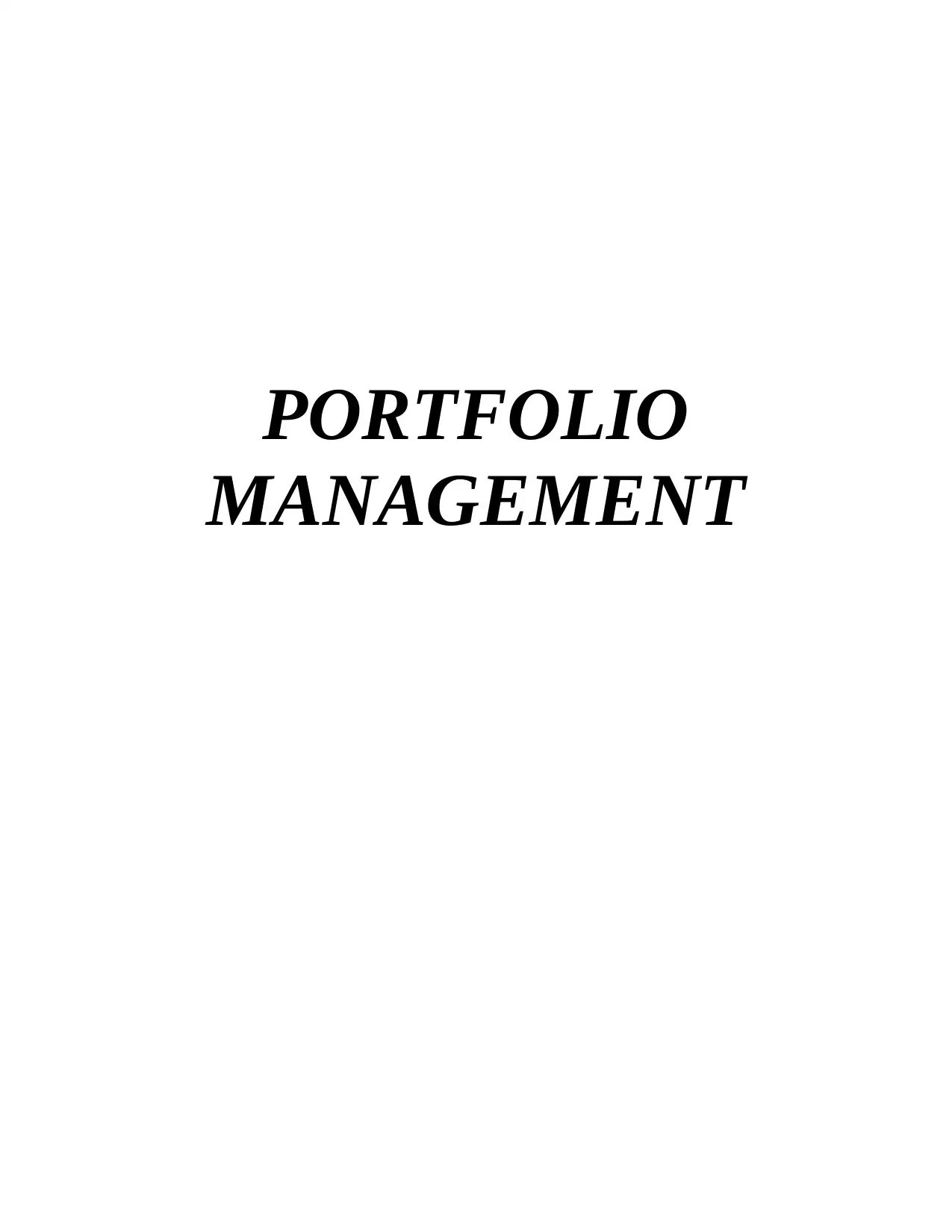
PORTFOLIO
MANAGEMENT
MANAGEMENT
Secure Best Marks with AI Grader
Need help grading? Try our AI Grader for instant feedback on your assignments.
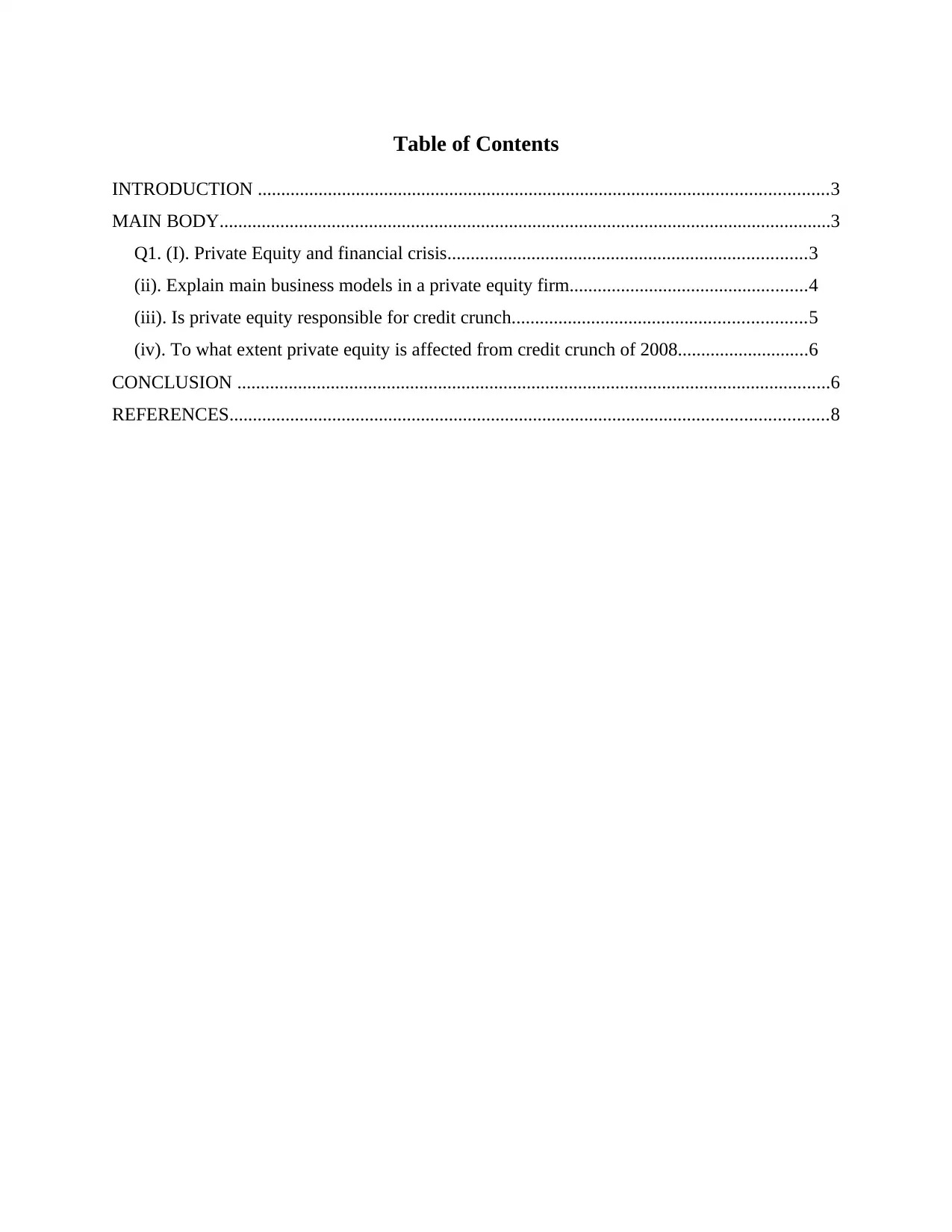
Table of Contents
INTRODUCTION ..........................................................................................................................3
MAIN BODY...................................................................................................................................3
Q1. (I). Private Equity and financial crisis.............................................................................3
(ii). Explain main business models in a private equity firm...................................................4
(iii). Is private equity responsible for credit crunch...............................................................5
(iv). To what extent private equity is affected from credit crunch of 2008............................6
CONCLUSION ...............................................................................................................................6
REFERENCES................................................................................................................................8
INTRODUCTION ..........................................................................................................................3
MAIN BODY...................................................................................................................................3
Q1. (I). Private Equity and financial crisis.............................................................................3
(ii). Explain main business models in a private equity firm...................................................4
(iii). Is private equity responsible for credit crunch...............................................................5
(iv). To what extent private equity is affected from credit crunch of 2008............................6
CONCLUSION ...............................................................................................................................6
REFERENCES................................................................................................................................8
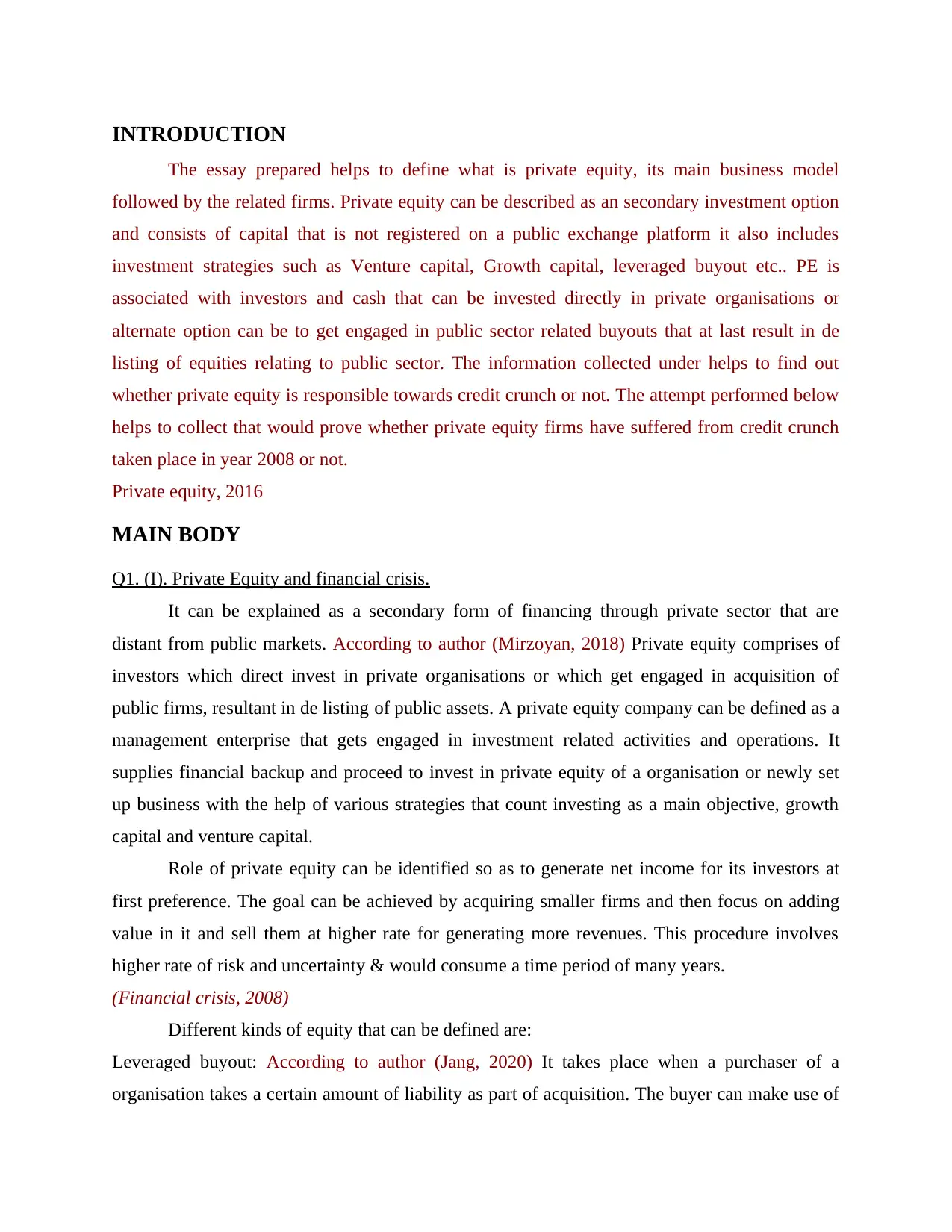
INTRODUCTION
The essay prepared helps to define what is private equity, its main business model
followed by the related firms. Private equity can be described as an secondary investment option
and consists of capital that is not registered on a public exchange platform it also includes
investment strategies such as Venture capital, Growth capital, leveraged buyout etc.. PE is
associated with investors and cash that can be invested directly in private organisations or
alternate option can be to get engaged in public sector related buyouts that at last result in de
listing of equities relating to public sector. The information collected under helps to find out
whether private equity is responsible towards credit crunch or not. The attempt performed below
helps to collect that would prove whether private equity firms have suffered from credit crunch
taken place in year 2008 or not.
Private equity, 2016
MAIN BODY
Q1. (I). Private Equity and financial crisis.
It can be explained as a secondary form of financing through private sector that are
distant from public markets. According to author (Mirzoyan, 2018) Private equity comprises of
investors which direct invest in private organisations or which get engaged in acquisition of
public firms, resultant in de listing of public assets. A private equity company can be defined as a
management enterprise that gets engaged in investment related activities and operations. It
supplies financial backup and proceed to invest in private equity of a organisation or newly set
up business with the help of various strategies that count investing as a main objective, growth
capital and venture capital.
Role of private equity can be identified so as to generate net income for its investors at
first preference. The goal can be achieved by acquiring smaller firms and then focus on adding
value in it and sell them at higher rate for generating more revenues. This procedure involves
higher rate of risk and uncertainty & would consume a time period of many years.
(Financial crisis, 2008)
Different kinds of equity that can be defined are:
Leveraged buyout: According to author (Jang, 2020) It takes place when a purchaser of a
organisation takes a certain amount of liability as part of acquisition. The buyer can make use of
The essay prepared helps to define what is private equity, its main business model
followed by the related firms. Private equity can be described as an secondary investment option
and consists of capital that is not registered on a public exchange platform it also includes
investment strategies such as Venture capital, Growth capital, leveraged buyout etc.. PE is
associated with investors and cash that can be invested directly in private organisations or
alternate option can be to get engaged in public sector related buyouts that at last result in de
listing of equities relating to public sector. The information collected under helps to find out
whether private equity is responsible towards credit crunch or not. The attempt performed below
helps to collect that would prove whether private equity firms have suffered from credit crunch
taken place in year 2008 or not.
Private equity, 2016
MAIN BODY
Q1. (I). Private Equity and financial crisis.
It can be explained as a secondary form of financing through private sector that are
distant from public markets. According to author (Mirzoyan, 2018) Private equity comprises of
investors which direct invest in private organisations or which get engaged in acquisition of
public firms, resultant in de listing of public assets. A private equity company can be defined as a
management enterprise that gets engaged in investment related activities and operations. It
supplies financial backup and proceed to invest in private equity of a organisation or newly set
up business with the help of various strategies that count investing as a main objective, growth
capital and venture capital.
Role of private equity can be identified so as to generate net income for its investors at
first preference. The goal can be achieved by acquiring smaller firms and then focus on adding
value in it and sell them at higher rate for generating more revenues. This procedure involves
higher rate of risk and uncertainty & would consume a time period of many years.
(Financial crisis, 2008)
Different kinds of equity that can be defined are:
Leveraged buyout: According to author (Jang, 2020) It takes place when a purchaser of a
organisation takes a certain amount of liability as part of acquisition. The buyer can make use of
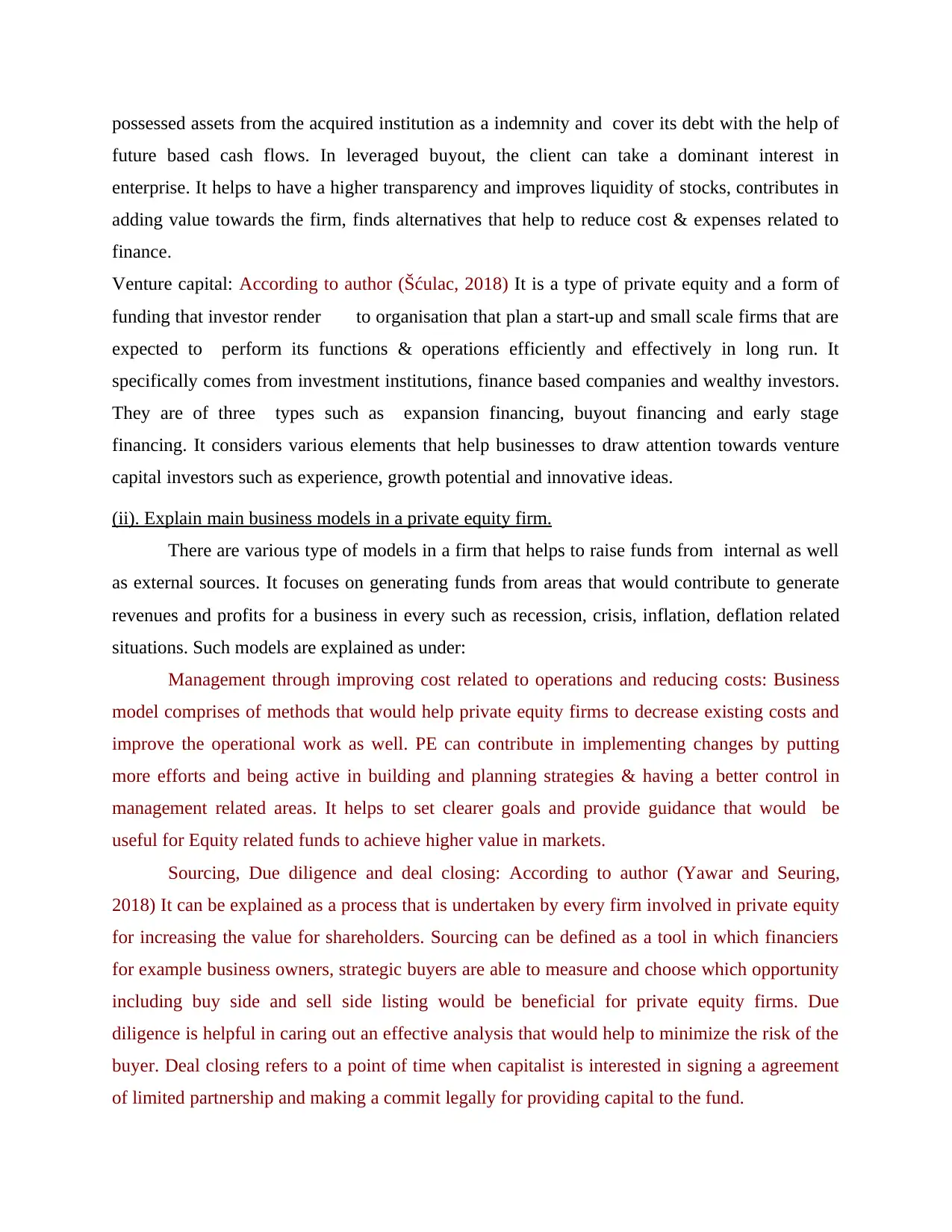
possessed assets from the acquired institution as a indemnity and cover its debt with the help of
future based cash flows. In leveraged buyout, the client can take a dominant interest in
enterprise. It helps to have a higher transparency and improves liquidity of stocks, contributes in
adding value towards the firm, finds alternatives that help to reduce cost & expenses related to
finance.
Venture capital: According to author (Šćulac, 2018) It is a type of private equity and a form of
funding that investor render to organisation that plan a start-up and small scale firms that are
expected to perform its functions & operations efficiently and effectively in long run. It
specifically comes from investment institutions, finance based companies and wealthy investors.
They are of three types such as expansion financing, buyout financing and early stage
financing. It considers various elements that help businesses to draw attention towards venture
capital investors such as experience, growth potential and innovative ideas.
(ii). Explain main business models in a private equity firm.
There are various type of models in a firm that helps to raise funds from internal as well
as external sources. It focuses on generating funds from areas that would contribute to generate
revenues and profits for a business in every such as recession, crisis, inflation, deflation related
situations. Such models are explained as under:
Management through improving cost related to operations and reducing costs: Business
model comprises of methods that would help private equity firms to decrease existing costs and
improve the operational work as well. PE can contribute in implementing changes by putting
more efforts and being active in building and planning strategies & having a better control in
management related areas. It helps to set clearer goals and provide guidance that would be
useful for Equity related funds to achieve higher value in markets.
Sourcing, Due diligence and deal closing: According to author (Yawar and Seuring,
2018) It can be explained as a process that is undertaken by every firm involved in private equity
for increasing the value for shareholders. Sourcing can be defined as a tool in which financiers
for example business owners, strategic buyers are able to measure and choose which opportunity
including buy side and sell side listing would be beneficial for private equity firms. Due
diligence is helpful in caring out an effective analysis that would help to minimize the risk of the
buyer. Deal closing refers to a point of time when capitalist is interested in signing a agreement
of limited partnership and making a commit legally for providing capital to the fund.
future based cash flows. In leveraged buyout, the client can take a dominant interest in
enterprise. It helps to have a higher transparency and improves liquidity of stocks, contributes in
adding value towards the firm, finds alternatives that help to reduce cost & expenses related to
finance.
Venture capital: According to author (Šćulac, 2018) It is a type of private equity and a form of
funding that investor render to organisation that plan a start-up and small scale firms that are
expected to perform its functions & operations efficiently and effectively in long run. It
specifically comes from investment institutions, finance based companies and wealthy investors.
They are of three types such as expansion financing, buyout financing and early stage
financing. It considers various elements that help businesses to draw attention towards venture
capital investors such as experience, growth potential and innovative ideas.
(ii). Explain main business models in a private equity firm.
There are various type of models in a firm that helps to raise funds from internal as well
as external sources. It focuses on generating funds from areas that would contribute to generate
revenues and profits for a business in every such as recession, crisis, inflation, deflation related
situations. Such models are explained as under:
Management through improving cost related to operations and reducing costs: Business
model comprises of methods that would help private equity firms to decrease existing costs and
improve the operational work as well. PE can contribute in implementing changes by putting
more efforts and being active in building and planning strategies & having a better control in
management related areas. It helps to set clearer goals and provide guidance that would be
useful for Equity related funds to achieve higher value in markets.
Sourcing, Due diligence and deal closing: According to author (Yawar and Seuring,
2018) It can be explained as a process that is undertaken by every firm involved in private equity
for increasing the value for shareholders. Sourcing can be defined as a tool in which financiers
for example business owners, strategic buyers are able to measure and choose which opportunity
including buy side and sell side listing would be beneficial for private equity firms. Due
diligence is helpful in caring out an effective analysis that would help to minimize the risk of the
buyer. Deal closing refers to a point of time when capitalist is interested in signing a agreement
of limited partnership and making a commit legally for providing capital to the fund.
Secure Best Marks with AI Grader
Need help grading? Try our AI Grader for instant feedback on your assignments.
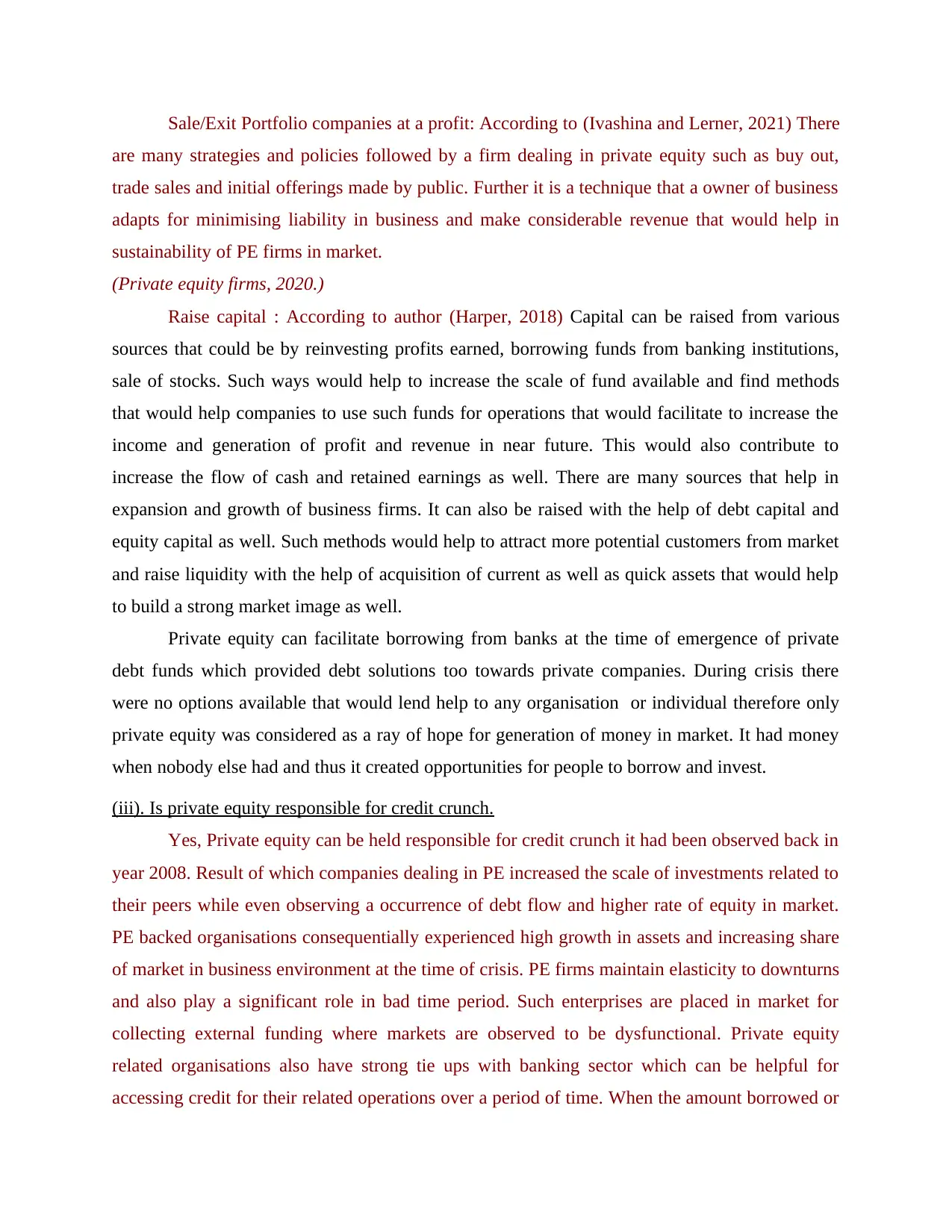
Sale/Exit Portfolio companies at a profit: According to (Ivashina and Lerner, 2021) There
are many strategies and policies followed by a firm dealing in private equity such as buy out,
trade sales and initial offerings made by public. Further it is a technique that a owner of business
adapts for minimising liability in business and make considerable revenue that would help in
sustainability of PE firms in market.
(Private equity firms, 2020.)
Raise capital : According to author (Harper, 2018) Capital can be raised from various
sources that could be by reinvesting profits earned, borrowing funds from banking institutions,
sale of stocks. Such ways would help to increase the scale of fund available and find methods
that would help companies to use such funds for operations that would facilitate to increase the
income and generation of profit and revenue in near future. This would also contribute to
increase the flow of cash and retained earnings as well. There are many sources that help in
expansion and growth of business firms. It can also be raised with the help of debt capital and
equity capital as well. Such methods would help to attract more potential customers from market
and raise liquidity with the help of acquisition of current as well as quick assets that would help
to build a strong market image as well.
Private equity can facilitate borrowing from banks at the time of emergence of private
debt funds which provided debt solutions too towards private companies. During crisis there
were no options available that would lend help to any organisation or individual therefore only
private equity was considered as a ray of hope for generation of money in market. It had money
when nobody else had and thus it created opportunities for people to borrow and invest.
(iii). Is private equity responsible for credit crunch.
Yes, Private equity can be held responsible for credit crunch it had been observed back in
year 2008. Result of which companies dealing in PE increased the scale of investments related to
their peers while even observing a occurrence of debt flow and higher rate of equity in market.
PE backed organisations consequentially experienced high growth in assets and increasing share
of market in business environment at the time of crisis. PE firms maintain elasticity to downturns
and also play a significant role in bad time period. Such enterprises are placed in market for
collecting external funding where markets are observed to be dysfunctional. Private equity
related organisations also have strong tie ups with banking sector which can be helpful for
accessing credit for their related operations over a period of time. When the amount borrowed or
are many strategies and policies followed by a firm dealing in private equity such as buy out,
trade sales and initial offerings made by public. Further it is a technique that a owner of business
adapts for minimising liability in business and make considerable revenue that would help in
sustainability of PE firms in market.
(Private equity firms, 2020.)
Raise capital : According to author (Harper, 2018) Capital can be raised from various
sources that could be by reinvesting profits earned, borrowing funds from banking institutions,
sale of stocks. Such ways would help to increase the scale of fund available and find methods
that would help companies to use such funds for operations that would facilitate to increase the
income and generation of profit and revenue in near future. This would also contribute to
increase the flow of cash and retained earnings as well. There are many sources that help in
expansion and growth of business firms. It can also be raised with the help of debt capital and
equity capital as well. Such methods would help to attract more potential customers from market
and raise liquidity with the help of acquisition of current as well as quick assets that would help
to build a strong market image as well.
Private equity can facilitate borrowing from banks at the time of emergence of private
debt funds which provided debt solutions too towards private companies. During crisis there
were no options available that would lend help to any organisation or individual therefore only
private equity was considered as a ray of hope for generation of money in market. It had money
when nobody else had and thus it created opportunities for people to borrow and invest.
(iii). Is private equity responsible for credit crunch.
Yes, Private equity can be held responsible for credit crunch it had been observed back in
year 2008. Result of which companies dealing in PE increased the scale of investments related to
their peers while even observing a occurrence of debt flow and higher rate of equity in market.
PE backed organisations consequentially experienced high growth in assets and increasing share
of market in business environment at the time of crisis. PE firms maintain elasticity to downturns
and also play a significant role in bad time period. Such enterprises are placed in market for
collecting external funding where markets are observed to be dysfunctional. Private equity
related organisations also have strong tie ups with banking sector which can be helpful for
accessing credit for their related operations over a period of time. When the amount borrowed or
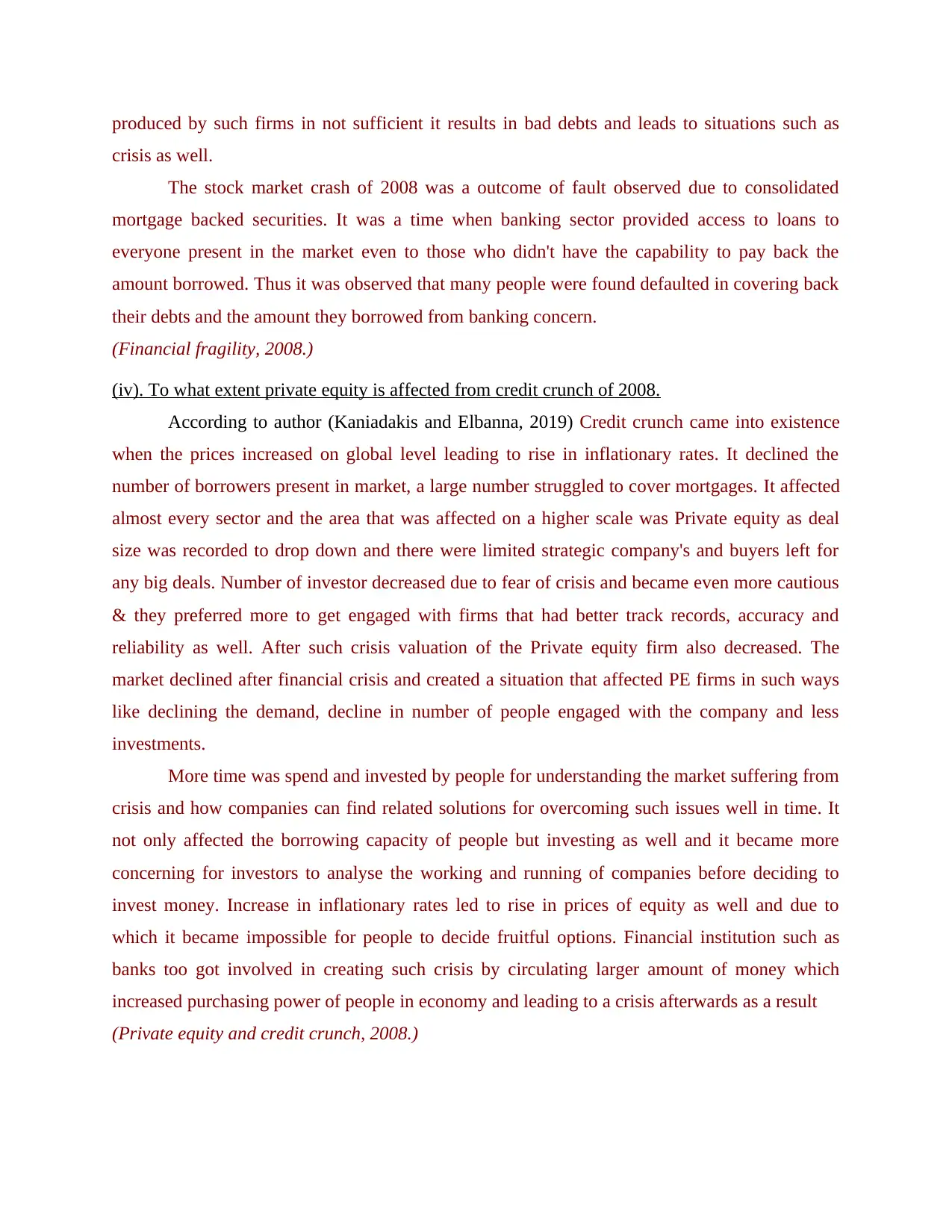
produced by such firms in not sufficient it results in bad debts and leads to situations such as
crisis as well.
The stock market crash of 2008 was a outcome of fault observed due to consolidated
mortgage backed securities. It was a time when banking sector provided access to loans to
everyone present in the market even to those who didn't have the capability to pay back the
amount borrowed. Thus it was observed that many people were found defaulted in covering back
their debts and the amount they borrowed from banking concern.
(Financial fragility, 2008.)
(iv). To what extent private equity is affected from credit crunch of 2008.
According to author (Kaniadakis and Elbanna, 2019) Credit crunch came into existence
when the prices increased on global level leading to rise in inflationary rates. It declined the
number of borrowers present in market, a large number struggled to cover mortgages. It affected
almost every sector and the area that was affected on a higher scale was Private equity as deal
size was recorded to drop down and there were limited strategic company's and buyers left for
any big deals. Number of investor decreased due to fear of crisis and became even more cautious
& they preferred more to get engaged with firms that had better track records, accuracy and
reliability as well. After such crisis valuation of the Private equity firm also decreased. The
market declined after financial crisis and created a situation that affected PE firms in such ways
like declining the demand, decline in number of people engaged with the company and less
investments.
More time was spend and invested by people for understanding the market suffering from
crisis and how companies can find related solutions for overcoming such issues well in time. It
not only affected the borrowing capacity of people but investing as well and it became more
concerning for investors to analyse the working and running of companies before deciding to
invest money. Increase in inflationary rates led to rise in prices of equity as well and due to
which it became impossible for people to decide fruitful options. Financial institution such as
banks too got involved in creating such crisis by circulating larger amount of money which
increased purchasing power of people in economy and leading to a crisis afterwards as a result
(Private equity and credit crunch, 2008.)
crisis as well.
The stock market crash of 2008 was a outcome of fault observed due to consolidated
mortgage backed securities. It was a time when banking sector provided access to loans to
everyone present in the market even to those who didn't have the capability to pay back the
amount borrowed. Thus it was observed that many people were found defaulted in covering back
their debts and the amount they borrowed from banking concern.
(Financial fragility, 2008.)
(iv). To what extent private equity is affected from credit crunch of 2008.
According to author (Kaniadakis and Elbanna, 2019) Credit crunch came into existence
when the prices increased on global level leading to rise in inflationary rates. It declined the
number of borrowers present in market, a large number struggled to cover mortgages. It affected
almost every sector and the area that was affected on a higher scale was Private equity as deal
size was recorded to drop down and there were limited strategic company's and buyers left for
any big deals. Number of investor decreased due to fear of crisis and became even more cautious
& they preferred more to get engaged with firms that had better track records, accuracy and
reliability as well. After such crisis valuation of the Private equity firm also decreased. The
market declined after financial crisis and created a situation that affected PE firms in such ways
like declining the demand, decline in number of people engaged with the company and less
investments.
More time was spend and invested by people for understanding the market suffering from
crisis and how companies can find related solutions for overcoming such issues well in time. It
not only affected the borrowing capacity of people but investing as well and it became more
concerning for investors to analyse the working and running of companies before deciding to
invest money. Increase in inflationary rates led to rise in prices of equity as well and due to
which it became impossible for people to decide fruitful options. Financial institution such as
banks too got involved in creating such crisis by circulating larger amount of money which
increased purchasing power of people in economy and leading to a crisis afterwards as a result
(Private equity and credit crunch, 2008.)
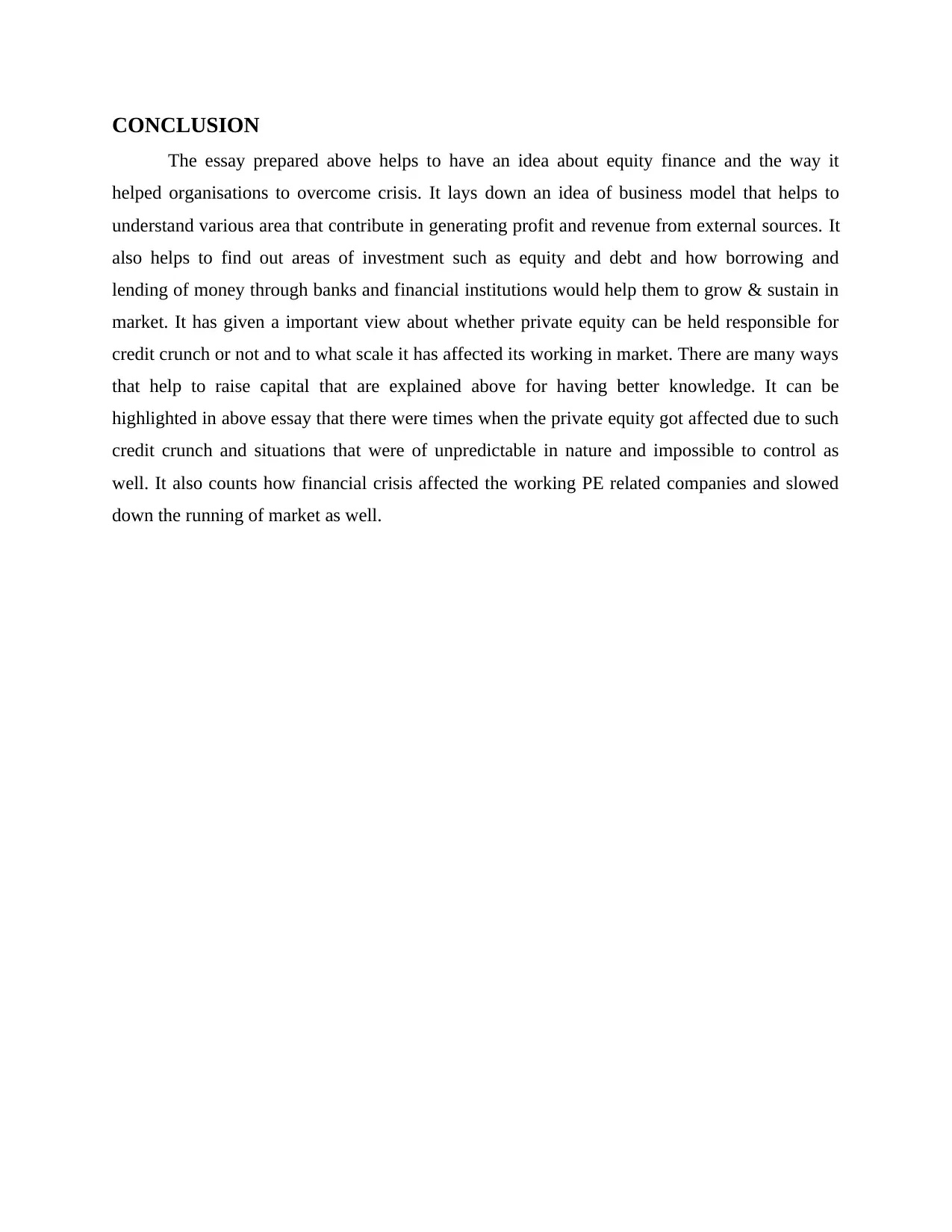
CONCLUSION
The essay prepared above helps to have an idea about equity finance and the way it
helped organisations to overcome crisis. It lays down an idea of business model that helps to
understand various area that contribute in generating profit and revenue from external sources. It
also helps to find out areas of investment such as equity and debt and how borrowing and
lending of money through banks and financial institutions would help them to grow & sustain in
market. It has given a important view about whether private equity can be held responsible for
credit crunch or not and to what scale it has affected its working in market. There are many ways
that help to raise capital that are explained above for having better knowledge. It can be
highlighted in above essay that there were times when the private equity got affected due to such
credit crunch and situations that were of unpredictable in nature and impossible to control as
well. It also counts how financial crisis affected the working PE related companies and slowed
down the running of market as well.
The essay prepared above helps to have an idea about equity finance and the way it
helped organisations to overcome crisis. It lays down an idea of business model that helps to
understand various area that contribute in generating profit and revenue from external sources. It
also helps to find out areas of investment such as equity and debt and how borrowing and
lending of money through banks and financial institutions would help them to grow & sustain in
market. It has given a important view about whether private equity can be held responsible for
credit crunch or not and to what scale it has affected its working in market. There are many ways
that help to raise capital that are explained above for having better knowledge. It can be
highlighted in above essay that there were times when the private equity got affected due to such
credit crunch and situations that were of unpredictable in nature and impossible to control as
well. It also counts how financial crisis affected the working PE related companies and slowed
down the running of market as well.
Paraphrase This Document
Need a fresh take? Get an instant paraphrase of this document with our AI Paraphraser
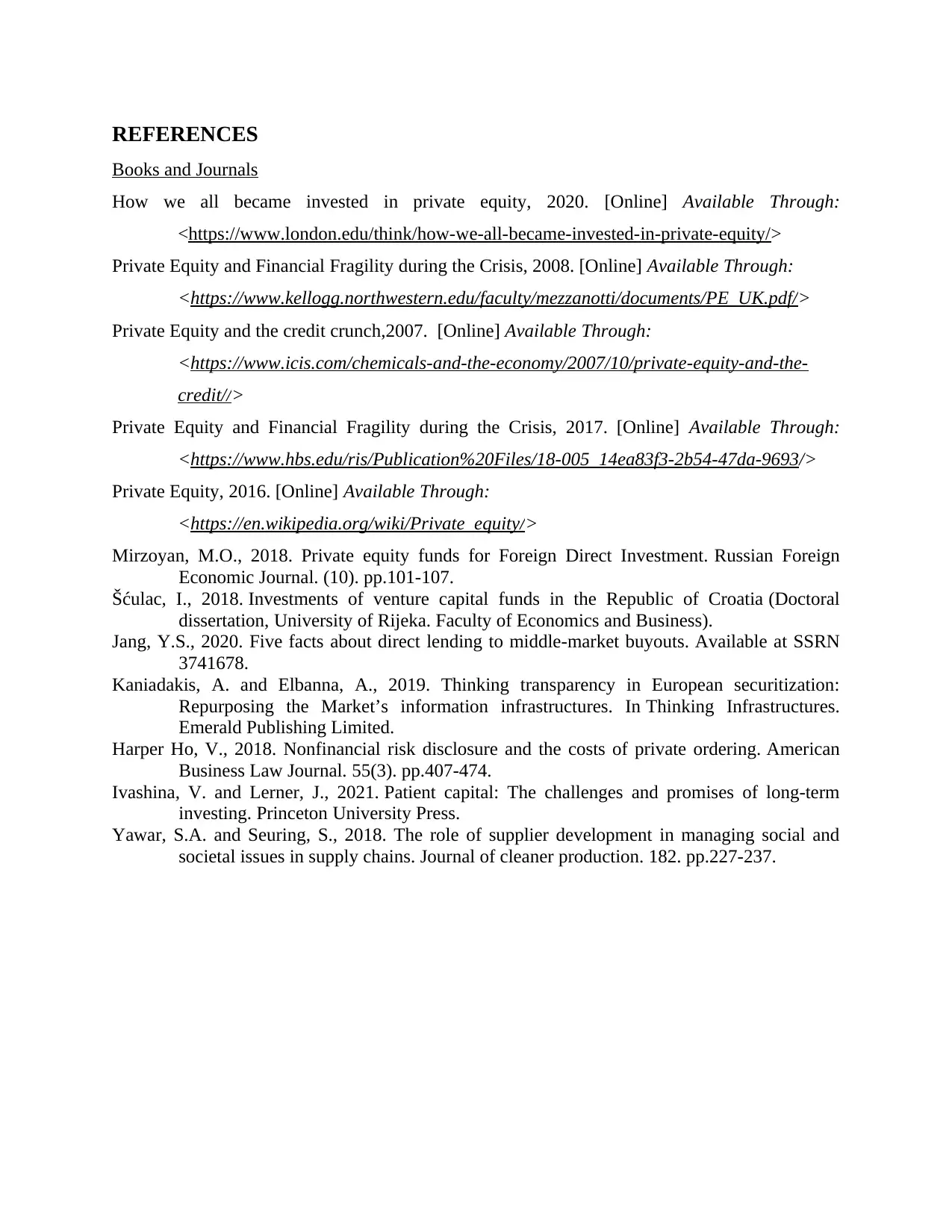
REFERENCES
Books and Journals
How we all became invested in private equity, 2020. [Online] Available Through:
<https://www.london.edu/think/how-we-all-became-invested-in-private-equity/>
Private Equity and Financial Fragility during the Crisis, 2008. [Online] Available Through:
<https://www.kellogg.northwestern.edu/faculty/mezzanotti/documents/PE_UK.pdf/>
Private Equity and the credit crunch,2007. [Online] Available Through:
<https://www.icis.com/chemicals-and-the-economy/2007/10/private-equity-and-the-
credit//>
Private Equity and Financial Fragility during the Crisis, 2017. [Online] Available Through:
<https://www.hbs.edu/ris/Publication%20Files/18-005_14ea83f3-2b54-47da-9693/>
Private Equity, 2016. [Online] Available Through:
<https://en.wikipedia.org/wiki/Private_equity/>
Mirzoyan, M.O., 2018. Private equity funds for Foreign Direct Investment. Russian Foreign
Economic Journal. (10). pp.101-107.
Šćulac, I., 2018. Investments of venture capital funds in the Republic of Croatia (Doctoral
dissertation, University of Rijeka. Faculty of Economics and Business).
Jang, Y.S., 2020. Five facts about direct lending to middle-market buyouts. Available at SSRN
3741678.
Kaniadakis, A. and Elbanna, A., 2019. Thinking transparency in European securitization:
Repurposing the Market’s information infrastructures. In Thinking Infrastructures.
Emerald Publishing Limited.
Harper Ho, V., 2018. Nonfinancial risk disclosure and the costs of private ordering. American
Business Law Journal. 55(3). pp.407-474.
Ivashina, V. and Lerner, J., 2021. Patient capital: The challenges and promises of long-term
investing. Princeton University Press.
Yawar, S.A. and Seuring, S., 2018. The role of supplier development in managing social and
societal issues in supply chains. Journal of cleaner production. 182. pp.227-237.
Books and Journals
How we all became invested in private equity, 2020. [Online] Available Through:
<https://www.london.edu/think/how-we-all-became-invested-in-private-equity/>
Private Equity and Financial Fragility during the Crisis, 2008. [Online] Available Through:
<https://www.kellogg.northwestern.edu/faculty/mezzanotti/documents/PE_UK.pdf/>
Private Equity and the credit crunch,2007. [Online] Available Through:
<https://www.icis.com/chemicals-and-the-economy/2007/10/private-equity-and-the-
credit//>
Private Equity and Financial Fragility during the Crisis, 2017. [Online] Available Through:
<https://www.hbs.edu/ris/Publication%20Files/18-005_14ea83f3-2b54-47da-9693/>
Private Equity, 2016. [Online] Available Through:
<https://en.wikipedia.org/wiki/Private_equity/>
Mirzoyan, M.O., 2018. Private equity funds for Foreign Direct Investment. Russian Foreign
Economic Journal. (10). pp.101-107.
Šćulac, I., 2018. Investments of venture capital funds in the Republic of Croatia (Doctoral
dissertation, University of Rijeka. Faculty of Economics and Business).
Jang, Y.S., 2020. Five facts about direct lending to middle-market buyouts. Available at SSRN
3741678.
Kaniadakis, A. and Elbanna, A., 2019. Thinking transparency in European securitization:
Repurposing the Market’s information infrastructures. In Thinking Infrastructures.
Emerald Publishing Limited.
Harper Ho, V., 2018. Nonfinancial risk disclosure and the costs of private ordering. American
Business Law Journal. 55(3). pp.407-474.
Ivashina, V. and Lerner, J., 2021. Patient capital: The challenges and promises of long-term
investing. Princeton University Press.
Yawar, S.A. and Seuring, S., 2018. The role of supplier development in managing social and
societal issues in supply chains. Journal of cleaner production. 182. pp.227-237.


1 out of 10
Related Documents
Your All-in-One AI-Powered Toolkit for Academic Success.
+13062052269
info@desklib.com
Available 24*7 on WhatsApp / Email
![[object Object]](/_next/static/media/star-bottom.7253800d.svg)
Unlock your academic potential
© 2024 | Zucol Services PVT LTD | All rights reserved.





